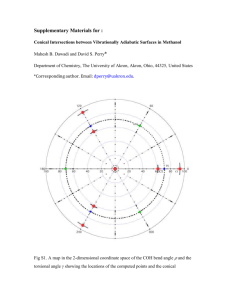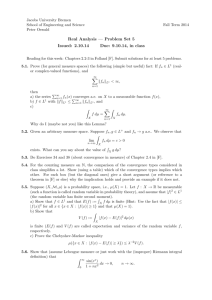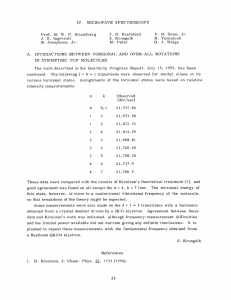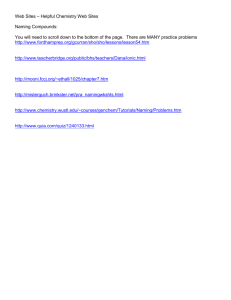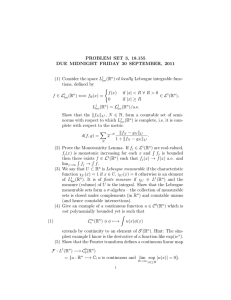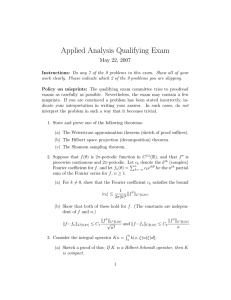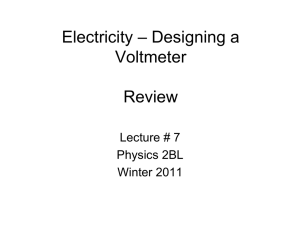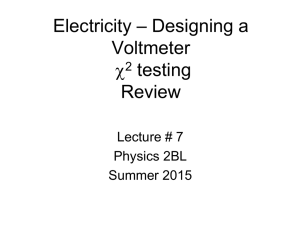Predicting Global Torsions
advertisement
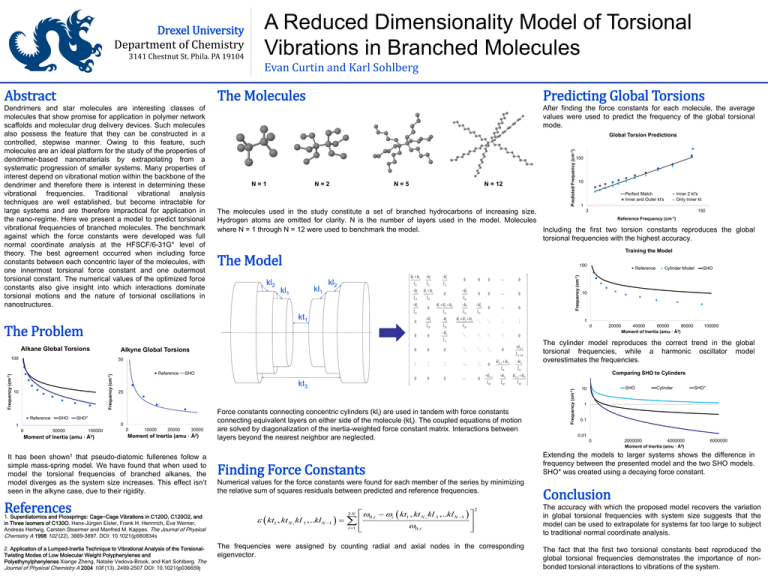
Drexel University Department of Chemistry 3141 Chestnut St. Phila. PA 19104 A Reduced Dimensionality Model of Torsional Vibrations in Branched Molecules Evan Curtin and Karl Sohlberg The Molecules After finding the force constants for each molecule, the average values were used to predict the frequency of the global torsional mode. Global Torsion Predictions N=1 N=2 N=5 The Model Frequency (cm-1) Frequency (cm-1) Reference SHO kl1 kl1 kl2 SHO kt3 25 SHO* 0 1 0 50000 100000 Moment of Inertia (amu · Å2) 0 10000 20000 30000 Moment of Inertia (amu · Å2) It has been shown1 that pseudo-diatomic fullerenes follow a simple mass-spring model. We have found that when used to model the torsional frequencies of branched alkanes, the model diverges as the system size increases. This effect isn’t seen in the alkyne case, due to their rigidity. References 1. Superdiatomics and Picosprings: Cage−Cage Vibrations in C120O, C120O2, and in Three Isomers of C130O. Hans-Jürgen Eisler, Frank H. Hennrich, Eva Werner, Andreas Hertwig, Carsten Stoermer and Manfred M. Kappes. The Journal of Physical Chemistry A 1998 102 (22), 3889-3897. DOI: 10.1021/jp980834s 2. Application of a Lumped-Inertia Technique to Vibrational Analysis of the TorsionalTwisting Modes of Low Molecular Weight Polyphenylenes and Polyethynylphenylenes Xiange Zheng, Natalie Vedova-Brook, and Karl Sohlberg. The Journal of Physical Chemistry A 2004 108 (13), 2499-2507 DOI: 10.1021/jp036659j Inner 2 kt's Only Inner kt 1 Force constants connecting concentric cylinders (kli) are used in tandem with force constants connecting equivalent layers on either side of the molecule (kti). The coupled equations of motion are solved by diagonalization of the inertia-weighted force constant matrix. Interactions between layers beyond the nearest neighbor are neglected. Numerical values for the force constants were found for each member of the series by minimizing the relative sum of squares residuals between predicted and reference frequencies. kt1 , kt N , kl 1 ,..kl N 1 Reference Cylinder Model SHO 10 1 0 20000 40000 60000 80000 Moment of Inertia (amu · Å2) 100000 The cylinder model reproduces the correct trend in the global torsional frequencies, while a harmonic oscillator model overestimates the frequencies. Comparing SHO to Cylinders SHO 10 Cylinder SHO* 1 0.1 0.01 0 2000000 4000000 Moment of Inertia (amu · Å2) 6000000 Extending the models to larger systems shows the difference in frequency between the presented model and the two SHO models. SHO* was created using a decaying force constant. Finding Force Constants 0,i i kt1 , kt N , kl 1 ,..kl N 1 i 1 0,i Frequency (cm-1) kl2 kl1 kl1 kt1 kt1 0 0 0 0 I I1L I1L 1L kt1 kl1 kt1 kl1 0 0 0 0 I1R I1R I1R kl1 kl1 kl2 kt2 kt1 kl2 0 0 0 I2L I2L I2L I2L kl1 kt1 kl1 kl2 kt2 0 I I I 2R 2R 2R kl2 0 0 0 I3L klN 1 0 0 0 0 I ( N 1) R klN 1 ktN ktN 0 I NL I NL kl kt kl kt 0 N 1 N N 1 N 0 0 0 I NR I NR I NR 50 10 Perfect Match Inner and Outer kt's 100 Alkyne Global Torsions Reference 10 Training the Model The Problem 100 100 3 150 The molecules used in the study constitute a set of branched hydrocarbons of increasing size. Reference Frequency (cm-1) Hydrogen atoms are omitted for clarity. N is the number of layers used in the model. Molecules where N = 1 through N = 12 were used to benchmark the model. Including the first two torsion constants reproduces the global torsional frequencies with the highest accuracy. kt1 Alkane Global Torsions N = 12 Predicted Frequency (cm-1) Dendrimers and star molecules are interesting classes of molecules that show promise for application in polymer network scaffolds and molecular drug delivery devices. Such molecules also possess the feature that they can be constructed in a controlled, stepwise manner. Owing to this feature, such molecules are an ideal platform for the study of the properties of dendrimer-based nanomaterials by extrapolating from a systematic progression of smaller systems. Many properties of interest depend on vibrational motion within the backbone of the dendrimer and therefore there is interest in determining these vibrational frequencies. Traditional vibrational analysis techniques are well established, but become intractable for large systems and are therefore impractical for application in the nano-regime. Here we present a model to predict torsional vibrational frequencies of branched molecules. The benchmark against which the force constants were developed was full normal coordinate analysis at the HFSCF/6-31G* level of theory. The best agreement occurred when including force constants between each concentric layer of the molecules, with one innermost torsional force constant and one outermost torsional constant. The numerical values of the optimized force constants also give insight into which interactions dominate torsional motions and the nature of torsional oscillations in nanostructures. Predicting Global Torsions Frequency (cm-1) Abstract 2 2N The frequencies were assigned by counting radial and axial nodes in the corresponding eigenvector. Conclusion The accuracy with which the proposed model recovers the variation in global torsional frequencies with system size suggests that the model can be used to extrapolate for systems far too large to subject to traditional normal coordinate analysis. The fact that the first two torsional constants best reproduced the global torsional frequencies demonstrates the importance of nonbonded torsional interactions to vibrations of the system. www.postersession.com
